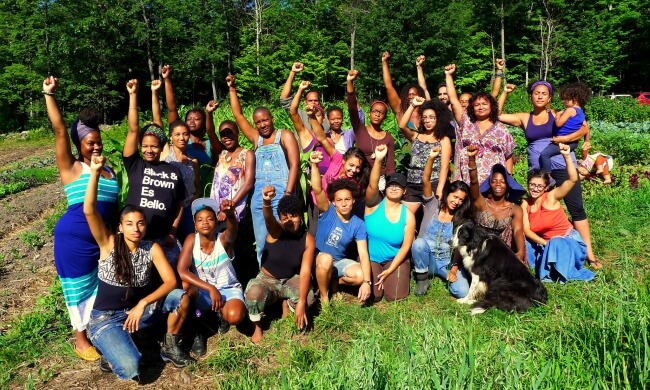In honor of Black History Month, we want to help uplift the voices and stories of Black leaders, farmers, and food justice activists. Leah Penniman has been an influential leader in food sovereignty and environmental justice work for over 20 years. As co-founder of Soul Fire Farm, “a BIPOC-centered community farm committed to ending racism and injustice in the food system” (www.soulfirefarm.org), she has inspired a new generation of growers and has fought for the accessibility of healthy fresh foods for communities of color.
She started Soul Fire Farm in Grafton, NY in 2011 after witnessing the segregated access to farm-fresh food for people of color in her community. Today, the farm provides a Community Supported Agriculture (CSA) program full of fresh, organic, and culturally relevant foods offered on a sliding pay-scale. The farm has also gained notoriety for its farming immersion program known as Black-Indigenous-People-of-Color Farming in Relationship with Earth (BIPOC FIRE). The program is designed for novice and intermediate growers of color interested in studying regenerative agriculture and intercultural growing practices. By providing a safe space to learn, grow, and heal together, the BIPOC FIRE program is empowering a new generation of growers to reclaim their roots and to serve as land stewards.
The following article by Penniman was first published in Yes! Magazine in 2017. This powerful piece addresses how racism shapes our current food system and encourages readers to take action through individual and institutional changes. Check out the entire article to see her full recommendations and the accompanying infographics.
-Emily Chiara
Common Share Food Co-op
Community Engagement Coordinator
4 Not-So-Easy Ways to Dismantle Racism in the Food System
Our food system is built on stolen land and exploited labor. Here’s what we can do to fix it.
Leah Penniman posted Apr 27, 2017
Racism is built into the DNA of the United States’ food system. It began with the genocidal theft of land from First Nations people, and continued with the kidnapping of my ancestors from the shores of West Africa. Under the brutality of the whip and the devastation of broken families, enslaved Africans cultivated the tobacco and cotton that made America wealthy.
But the story doesn’t end with the Emancipation Proclamation. Later came convict leasing, a form of legalized slavery that kept many Southern black people on plantations—in some places until the late 1920s. Just a few decades later, Congress created the migrant guest-worker program, which imported agriculturalists from Mexico and other countries to labor in the fields for low wages.
All of this history combines to produce the racism I see today in my work as a farmer and activist for food justice. Farm management is among the whitest professions, while farm labor is predominantly brown and exploited. Meanwhile, people of color tend to suffer from diet-related illnesses such as diabetes and obesity, and to live in “food apartheid” neighborhoods—high-poverty areas flooded with fast food and corner stores, but lacking healthy food options. While some writers refer to these areas as “food deserts,” I prefer the term “food apartheid” because this is a human-created system of segregation, not a natural ecosystem.
Our food system needs a redesign if it’s to feed us without perpetuating racism and oppression.
With this new administration, that’s even truer today than before. After the election of a presidential candidate who ran on a racist, misogynistic, and xenophobic platform, the power of white supremacy in the United States is laid bare. Just as our ancestral mothers braided seeds of rice and okra into their hair before boarding slave ships, believing in a future of harvest in the face of brutality, so must we maintain courage and hope in these terrifying times.
As we work toward a racially just food system, abandoning the “colonizer” mentality that first created the problems is crucial. The communities at the frontlines of food justice are composed of black, Latino, and indigenous people, refugees and immigrants, and people criminalized by the penal system. We need to listen before we speak and follow the lead of those directly affected by the issues.
This article offers four infographics that explain different aspects of the problem. It also contains two solutions for each of them—some of the systemic changes we’d need to fully address it, and a way for individuals to take action. I hope these can be practical seeds of hope toward a racially just food system.
1. Uphold everyone’s right to land
After decades of discrimination by the federal government, Black farmers have lost almost all of our land. Reparations for past harm are the first step to justice.
2. Honor the people who grow our food
The U.S. does not provide a living wage, health care, or labor protections to the farmworkers who feed us. It’s time to update the law and stop exploiting agricultural workers.
3. Eliminate Food Apartheid
Communities of color have less access to life-giving, healthy food, resulting in high rates of obesity and diabetes. Policies and actions that boost community control are part of the answer.
4. Support Farmers of Color
Access to education and start-up funding remain barriers for aspiring farmers of color. Some federal programs have made progress, but need more funding to meet the scale of the challenge.
View the full article by Leah Penniman published through Yes!Magazine at: https://www.yesmagazine.org/people-power/4-not-so-easy-ways-to-dismantle-racism-in-the-food-system-20170427

